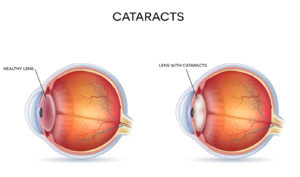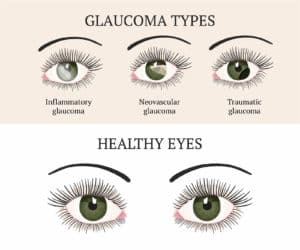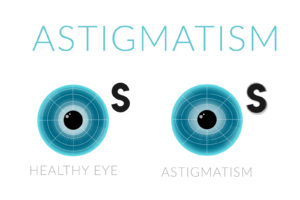
Does Astigmatism Have an Impact on Driving Performance?
Astigmatism may not be the best-known eye disorder, but it’s certainly among the most common. Some studies have estimated the prevalence of astigmatism in children aged 5-17 to be as high as 28 percent, a number that’s widely believed to increase with age.
Blurred vision is a hallmark symptom of astigmatism. And while effective corrective measures do exist, people with astigmatism still run into difficulties when attempting to perform certain tasks. Driving presents a particular challenge for some, but not all astigmatic individuals. We’ll go into a little more detail about what astigmatism is, how to deal with it, and how it can make getting behind the wheel a dangerous proposition in some cases.
What Is Astigmatism?
In a perfectly functioning eye, light passes through the cornea and lens. From there, it reaches a single focal point on the retina, a membrane at the back of the eye responsible for perceiving light. When everything works properly, those rays all converge accurately onto the retina, allowing sharp, clear sight.
Astigmatic eyes are a little different. While several different factors can give rise to astigmatism, the most common is a physically elongated eye. This “football” shape, as opposed to the spherical one in normal eyes, doesn’t focus light as effectively onto the retina, instead slightly misdirecting some of it. This is how astigmatism affects your vision.
Blurred vision is the most common result. The actual severity of the symptom, however, is highly variable. People with mild cases may go through life without ever noticing any defects in their vision. But, more severe astigmatism often requires extensive correction.
Detecting Astigmatism
Checking for astigmatism is a routine component of most eye exams. As astigmatism can strongly affect visual acuity, ophthalmologists often catch it while testing eyesight using letter boards. Difficulty reading smaller lines is generally indicative of a vision disorder.
Keratometry has recently become more widespread in up-to-date clinics. Keratometers cast light on an eye, then measure its reflection in order to determine the shape of the cornea. Instrumental for physicians working to fit a client with contacts, keratometers can also help diagnose astigmatism by revealing abnormally shaped eyes.
Similar, but more advanced technology may be en route. Wavefront analysis has broken new ground in laser eye surgery by allowing surgeons to accurately determine the exact refractory index of an eye. The technology has shown promise when used as an eye examination tool. It may also help ophthalmologists catch astigmatism in the future.
Treating Astigmatism
Thankfully, treating astigmatism tends to be relatively straightforward. Corrective eyeglasses address the problem by providing focusing power to specific parts of a user’s eye, compensating for distortions caused by astigmatism.
Contact lenses are also popular. Soft contacts aren’t always the best solution, as they mimic the shape of the eyeball (the basic problem behind many cases of astigmatism). However, rigid lenses work well, as do specialized toric soft contacts. Toric lenses are shaped slightly differently from standard, spherical contacts. Their irregular design creates differing focal strengths around the lens, allowing them to address the specific complications of astigmatism.
But, if you have astigmatism, that doesn’t necessarily mean a corrective lens sentence. Research is proving that the common condition can be treated naturally with a diet high in vision-enhancing vitamins and minerals. Eye vitamins, like the Ocu-Plus Formula, can help clear up some of the astigmatic blur, helping you avoid the prospect of a costly surgery and sometimes even letting you ditch your corrective lenses. You can also try specific eye exercises for astigmatism.
Driving Difficulties

Even with treatment, astigmatism can make driving a risky activity. For most, this typically applies to night driving. Astigmatism is notorious for giving sufferers severely reduced night vision, possibly due to pupil dilation in low-light conditions, which can exacerbate focal difficulties.
Even during the day, people with astigmatism can experience problems with light and some will see halos, blurring, and severe distortion in certain conditions. Increased darkness worsens all these difficulties. It may even get to the point where activities that require a high degree of visual acuity, such as driving, become difficult or even impossible to do safely.
Corrective lenses are also more likely to cause complications at night. Most astigmatic individuals wear either glasses or contacts. Glasses can create glare, which is especially noticeable with artificial lighting after dark. Contacts can be even worse – if not kept well-hydrated, they can dry out after a long day, causing discomfort and worsened sight.
Driving with Astigmatism
Anyone with astigmatism concerned about night driving should first look to correct their vision as much as possible. As mentioned, eye vitamins allow you to improve your vision, but choosing the right pair of glasses or contacts is also vital.
If night driving with astigmatism is a particular concern, then certain steps can help. Glasses with anti-reflective treatment are much less likely to worsen glare than other options. They can also help cut down on visual distortions in low light. For contact wearers, inquire about hybrid lenses. Some contacts specially designed to treat astigmatism have a rigid outer rim, but a more flexible center. These hybrid lenses may offer a better solution for some.
Otherwise, do your best to keep your eyes hydrated. Using over-the-counter contact moisturizing drops will prevent the ill effects of dry lenses.
Despite all advances in corrective technology, some individuals with astigmatism will still find themselves unable to drive safely. Licensing regulations vary from state to state. Physicians will evaluate most individuals with extremely poor vision to determine what conditions they’re able to drive in. It’s possible to receive a license that allows driving during the day, but with a condition that states that the holder is unable to legally drive at night.
If you do find yourself limited by your astigmatism, then it’s time to start looking into public transit options. Fortunately, states are required by law to provide adequate transport to individuals with low vision. Many metropolitan areas will also have curbside pickup paratransit services available to visually impaired users. So, living with astigmatism is not impossible, especially when you work to incorporate eye-healthy habits into your daily routine.
Our Rebuild Your Vision Ocu-Plus Formula Contains All 17 Vitamins, Minerals, and Herbal Supplements to Improve Your Eye Health!












Contact me If you have any advice or helpfull sugestions. thanks Lynn Smith
I have had catarac surgery on both eyes and lasar surgery on both to clean up the lenses. I had this done by one of the best in the buisness and I think I could see better before. I have very poor night vision with glare and halos as well as distortion and bad distance perception. I am looking for any kind of help or advice. thank you Lynn M. Smith